NISSAN LATIO 2009 Service Repair Manual
Manufacturer: NISSAN, Model Year: 2009, Model line: LATIO, Model: NISSAN LATIO 2009Pages: 4331, PDF Size: 58.04 MB
Page 2271 of 4331
![NISSAN LATIO 2009 Service Repair Manual DTC P1572 ASCD BRAKE SWITCH
EC-915
< SERVICE INFOMATION >
[MR TYPE 1] C
D E
F
G H
I
J
K L
M A EC
NP
O
3. Check continuity between ASCD clutch switch terminals 1 and 2
under the following conditions.
I NISSAN LATIO 2009 Service Repair Manual DTC P1572 ASCD BRAKE SWITCH
EC-915
< SERVICE INFOMATION >
[MR TYPE 1] C
D E
F
G H
I
J
K L
M A EC
NP
O
3. Check continuity between ASCD clutch switch terminals 1 and 2
under the following conditions.
I](/img/5/57359/w960_57359-2270.png)
DTC P1572 ASCD BRAKE SWITCH
EC-915
< SERVICE INFOMATION >
[MR TYPE 1] C
D E
F
G H
I
J
K L
M A EC
NP
O
3. Check continuity between ASCD clutch switch terminals 1 and 2
under the following conditions.
If NG, adjust ASCD clutch switch installation, refer to CL-5 , and
perform step 3 again.
STOP LAMP SWITCH 1. Turn ignition switch OFF.
2. Disconnect stop lamp switch harness connector.
3. Check continuity between stop lamp switch terminals 1 and 2 under the following conditions.
If NG, adjust stop lamp switch installation, refer to BR-6 , and perform step 3 again.
Condition Continuity
Clutch pedal: Fully released. Should exist.
Clutch pedal: Slightly depressed. Should not exist. SEC023D
Condition Continuity
Brake pedal: Fully released. Should not exist.
Brake pedal: Slightly depressed. Should exist. PBIB3318E
Page 2272 of 4331
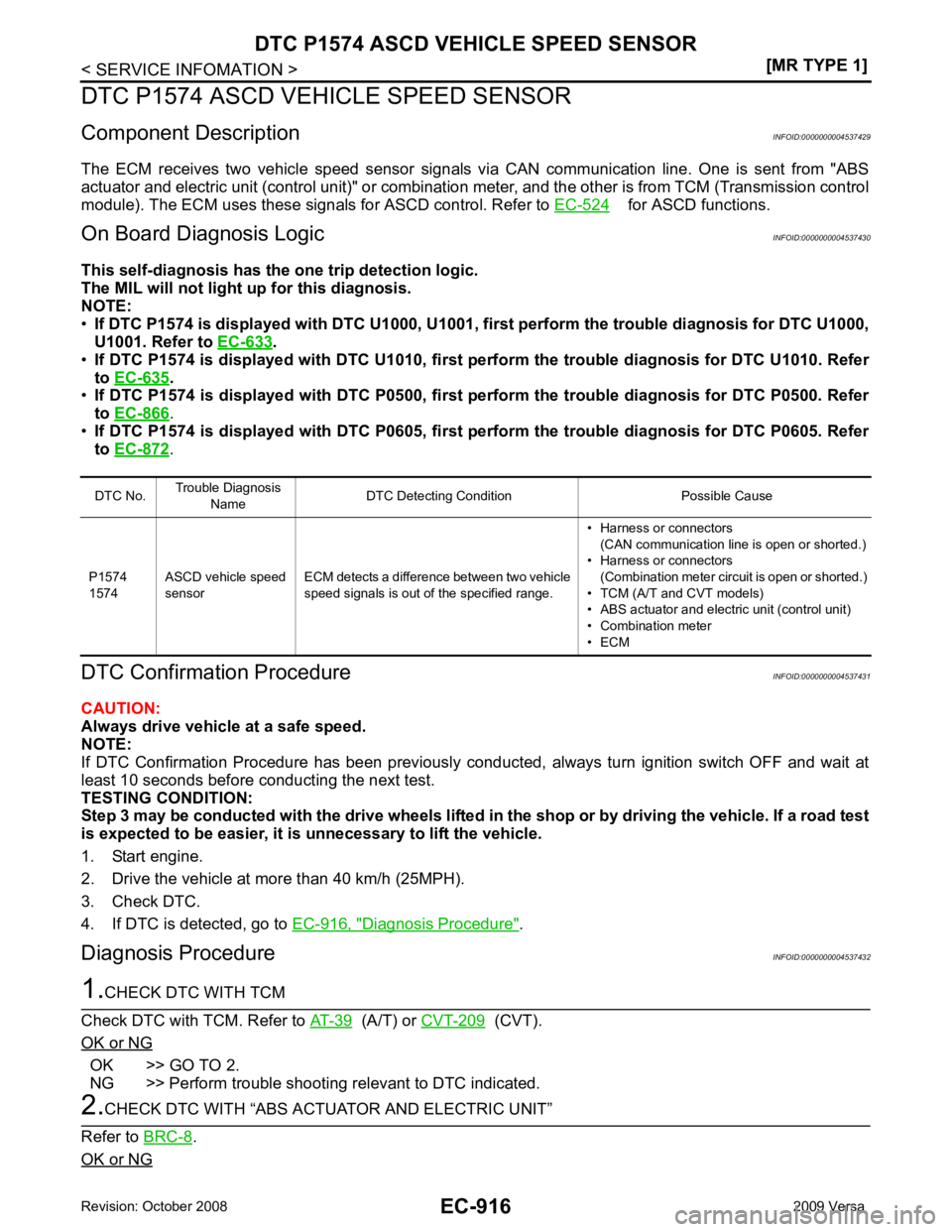
for ASCD functions.
On Board Diagn osis Logic INFOID:0000000004537430
This self-diagnosis has the one trip detection logic.
The MIL will not light up for this diagnosis.
NOTE:
• If DTC P1574 is displayed with DTC U1000, U1001, first perform the trouble diagnosis for DTC U1000,
U1001. Refer to EC-633 .
• If DTC P1574 is displayed with DTC U1010, first pe rform the trouble diagnosis for DTC U1010. Refer
to EC-635 .
• If DTC P1574 is displayed with DTC P0500, first pe rform the trouble diagnosis for DTC P0500. Refer
to EC-866 Diagnosis Procedure " .
Diagnosis Procedure INFOID:0000000004537432 (A/T) or
CVT-209 (CVT).
OK or NG OK >> GO TO 2.
NG >> Perform trouble shooting relevant to DTC indicated. .
OK or NG
Page 2273 of 4331

EC
NP
O
OK >> GO TO 3.
NG >> Repair or replace. .
>> INSPECTION END
Page 2274 of 4331
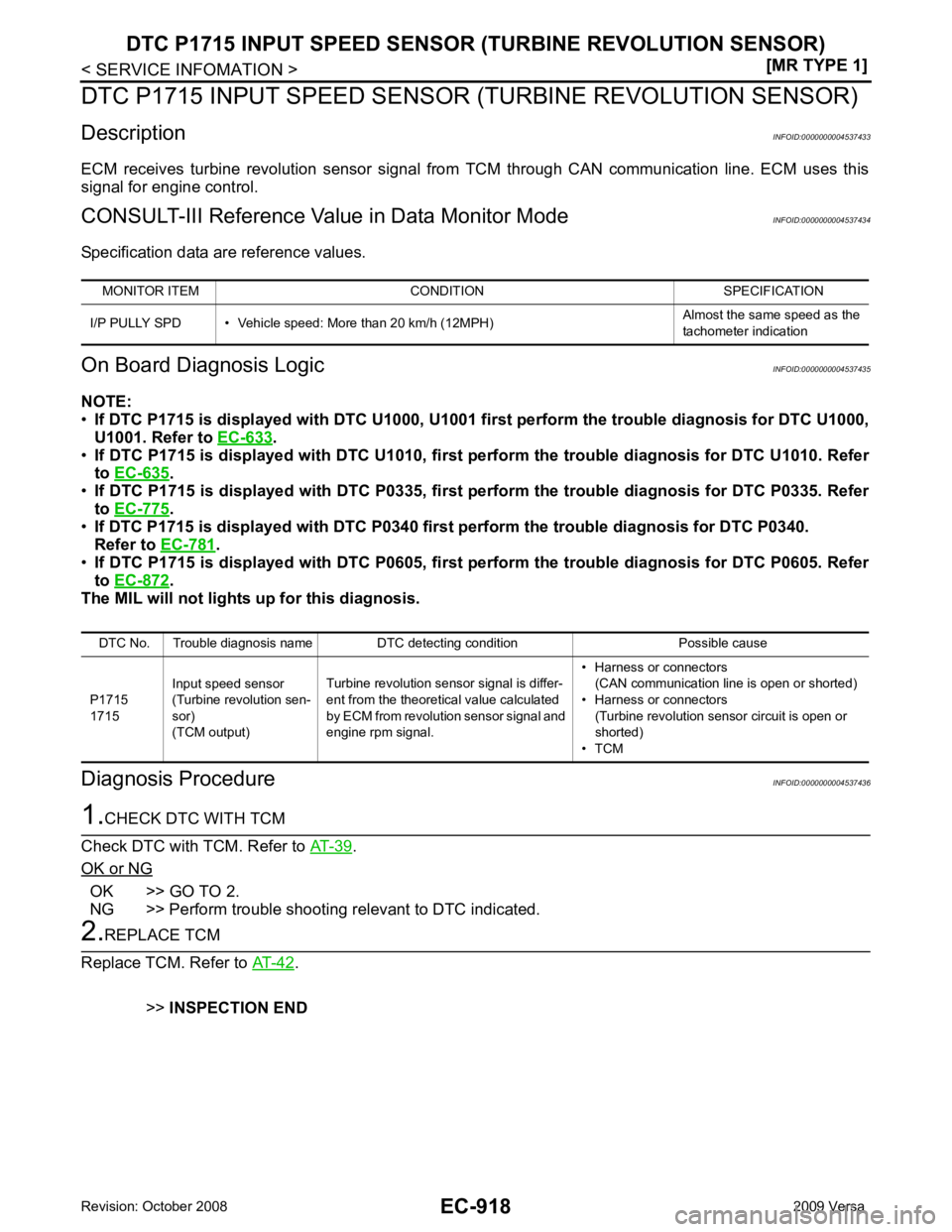
.
• If DTC P1715 is displayed with DTC U1010, first pe rform the trouble diagnosis for DTC U1010. Refer
to EC-635 .
• If DTC P1715 is displayed with DTC P0335, first pe rform the trouble diagnosis for DTC P0335. Refer
to EC-775 .
• If DTC P1715 is displayed with DTC P0340 first perform the trouble diagnosis for DTC P0340.
Refer to EC-781 .
• If DTC P1715 is displayed with DTC P0605, first pe rform the trouble diagnosis for DTC P0605. Refer
to EC-872 .
The MIL will not lights up for this diagnosis.
Diagnosis Procedure INFOID:0000000004537436.
OK or NG OK >> GO TO 2.
NG >> Perform trouble shooting relevant to DTC indicated. .
>> INSPECTION END
MONITOR ITEM CONDITION SPECIFICATION
I/P PULLY SPD • Vehicle speed: More than 20 km/h (12MPH) Almost the same speed as the
tachometer indication DTC No. Trouble diagnosis name DTC detecting condition Possible cause
P1715
1715 Input speed sensor
(Turbine revolution sen-
sor)
(TCM output) Turbine revolution sensor signal is differ-
ent from the theoretical value calculated
by ECM from revolution sensor signal and
engine rpm signal. • Harness or connectors
(CAN communication line is open or shorted)
• Harness or connectors
(Turbine revolution sensor circuit is open or
shorted)
• TCM
Page 2275 of 4331
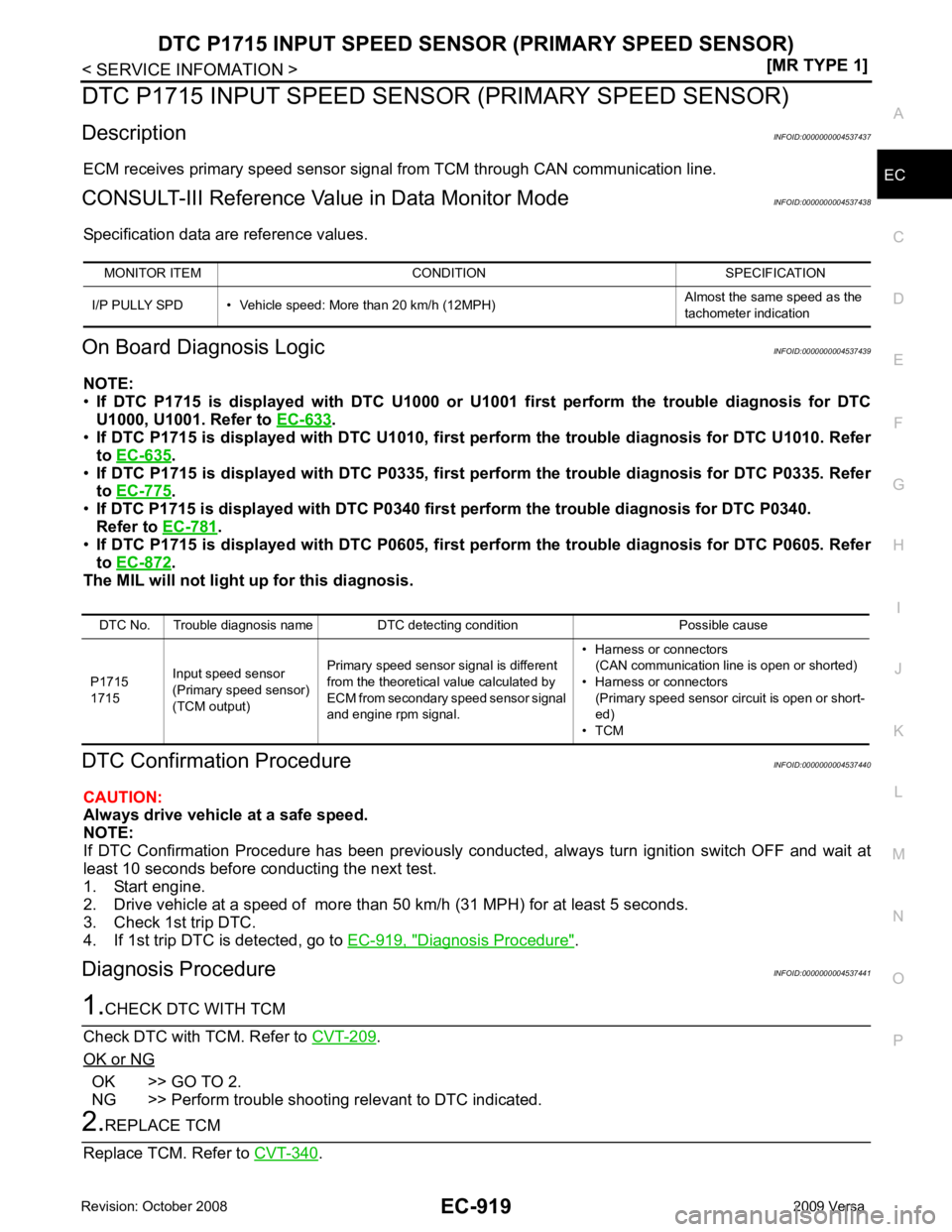
EC
NP
O
DTC P1715 INPUT SPEED SENS
OR (PRIMARY SPEED SENSOR)
Description INFOID:0000000004537437
ECM receives primary speed sensor signal from TCM through CAN communication line.
CONSULT-III Reference Val ue in Data Monitor Mode INFOID:0000000004537438
Specification data are reference values.
On Board Diagnosis Logic INFOID:0000000004537439
NOTE:
• If DTC P1715 is displayed with DTC U1000 or U 1001 first perform the trouble diagnosis for DTC
U1000, U1001. Refer to EC-633 .
• If DTC P1715 is displayed with DTC U1010, firs t perform the trouble diagnosis for DTC U1010. Refer
to EC-635 .
• If DTC P1715 is displayed with DT C P0335, first perform the trouble diagnosis for DTC P0335. Refer
to EC-775 .
• If DTC P1715 is displayed with DTC P0340 firs t perform the trouble diagnosis for DTC P0340.
Refer to EC-781 .
• If DTC P1715 is displayed with DT C P0605, first perform the trouble diagnosis for DTC P0605. Refer
to EC-872 .
The MIL will not light up for this diagnosis.
DTC Confirmation Procedure INFOID:0000000004537440
CAUTION:
Always drive vehicle at a safe speed.
NOTE:
If DTC Confirmation Procedure has been previously conduc ted, always turn ignition switch OFF and wait at
least 10 seconds before conducting the next test.
1. Start engine.
2. Drive vehicle at a speed of more than 50 km/h (31 MPH) for at least 5 seconds.
3. Check 1st trip DTC.
4. If 1st trip DTC is detected, go to EC-919, " Diagnosis Procedure " .
Diagnosis Procedure INFOID:0000000004537441.
OK or NG OK >> GO TO 2.
NG >> Perform trouble shooting relevant to DTC indicated. .
MONITOR ITEM CONDITION SPECIFICATION
I/P PULLY SPD • Vehicle speed: More than 20 km/h (12MPH) Almost the same speed as the
tachometer indication DTC No. Trouble diagnosis name DTC detecting condition Possible cause
P1715
1715 Input speed sensor
(Primary speed sensor)
(TCM output) Primary speed sensor signal is different
from the theoretical value calculated by
ECM from secondary speed sensor signal
and engine rpm signal. • Harness or connectors
(CAN communication line is open or shorted)
• Harness or connectors (Primary speed sensor circuit is open or short-
ed)
• TCM
Page 2276 of 4331

Page 2277 of 4331

EC
NP
O
DTC P1805 BRAKE SWITCH
Description INFOID:0000000004537442
Brake switch signal is applied to the ECM through t he stop lamp switch when the brake pedal is depressed.
This signal is used mainly to decrease the engine speed when the vehicle is driving.
CONSULT-III Reference Val ue in Data Monitor Mode INFOID:0000000004537443
Specification data are reference values.
On Board Diagnosis Logic INFOID:0000000004537444
The MIL will not light up for this self-diagnosis.
FAIL-SAFE MODE When the malfunction is detected, the ECM enters in fail-safe mode.
DTC Confirmation Procedure INFOID:0000000004537445
1. Turn ignition switch ON.
2. Fully depress the brake pedal for at least 5 seconds.
3. Erase the DTC.
4. Check 1st trip DTC.
5. If 1st trip DTC is detected, go to EC-923, " Diagnosis Procedure " .
MONITOR ITEM CONDITION SPECIFICATION
BRAKE SW • Ignition switch: ON Brake pedal: Fully released OFF
Brake pedal: Slightly depressed ON DTC No. Trouble diagnosis name DTC detecting condition Possible cause
P1805
1805 Brake switch A brake switch signal is not sent to ECM for
extremely long time while the vehicle is driv-
ing. • Harness or connectors
(Stop lamp switch circuit is open or shorted.)
• Stop lamp switch Engine operation condition in fail-fail safe mode
ECM controls the electric throttle control actuator by regulating the throttle opening to a small range. Therefore, acceleration will be poor.
Vehicle condition Driving condition Engine: Idling NormalAccelerating Poor acceleration
Page 2278 of 4331
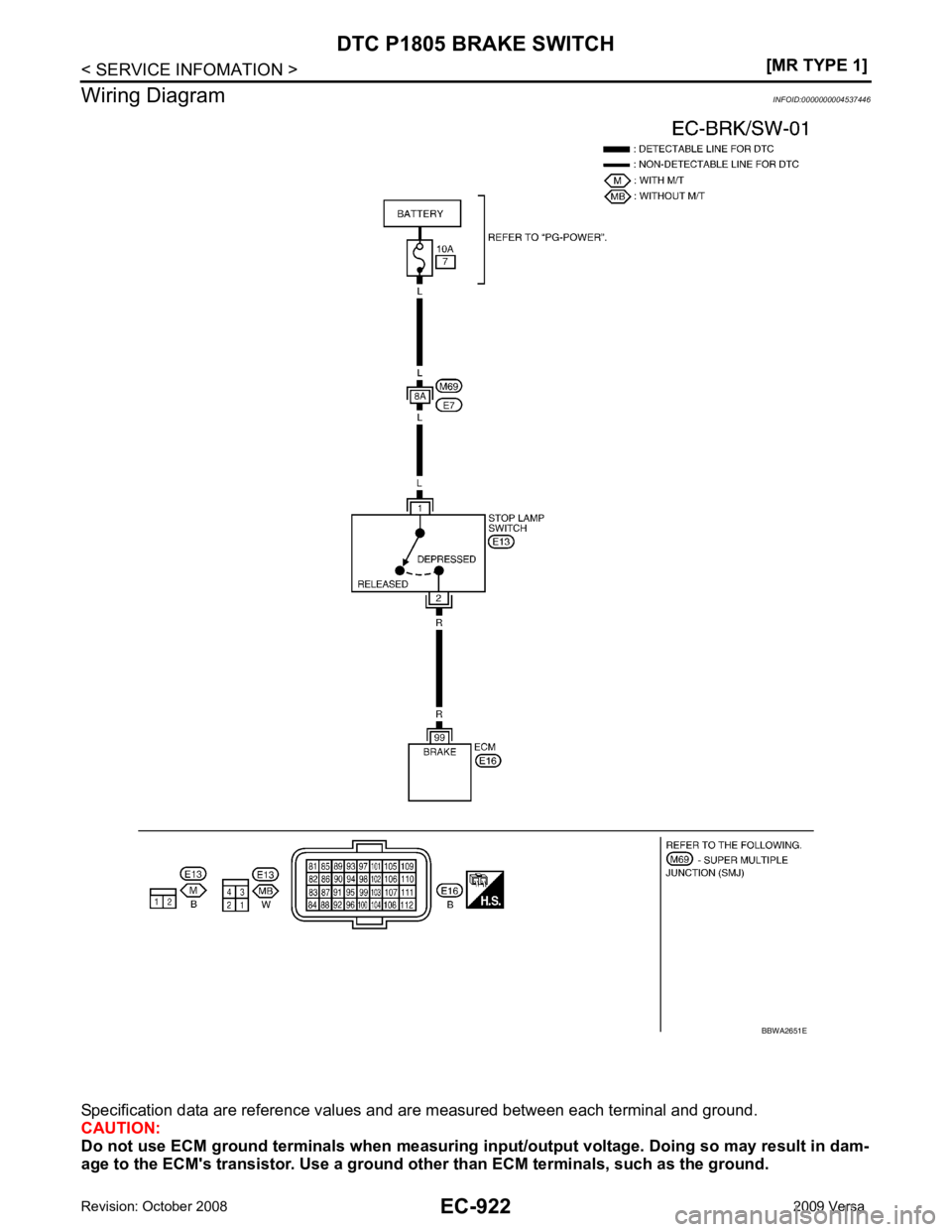
Page 2279 of 4331
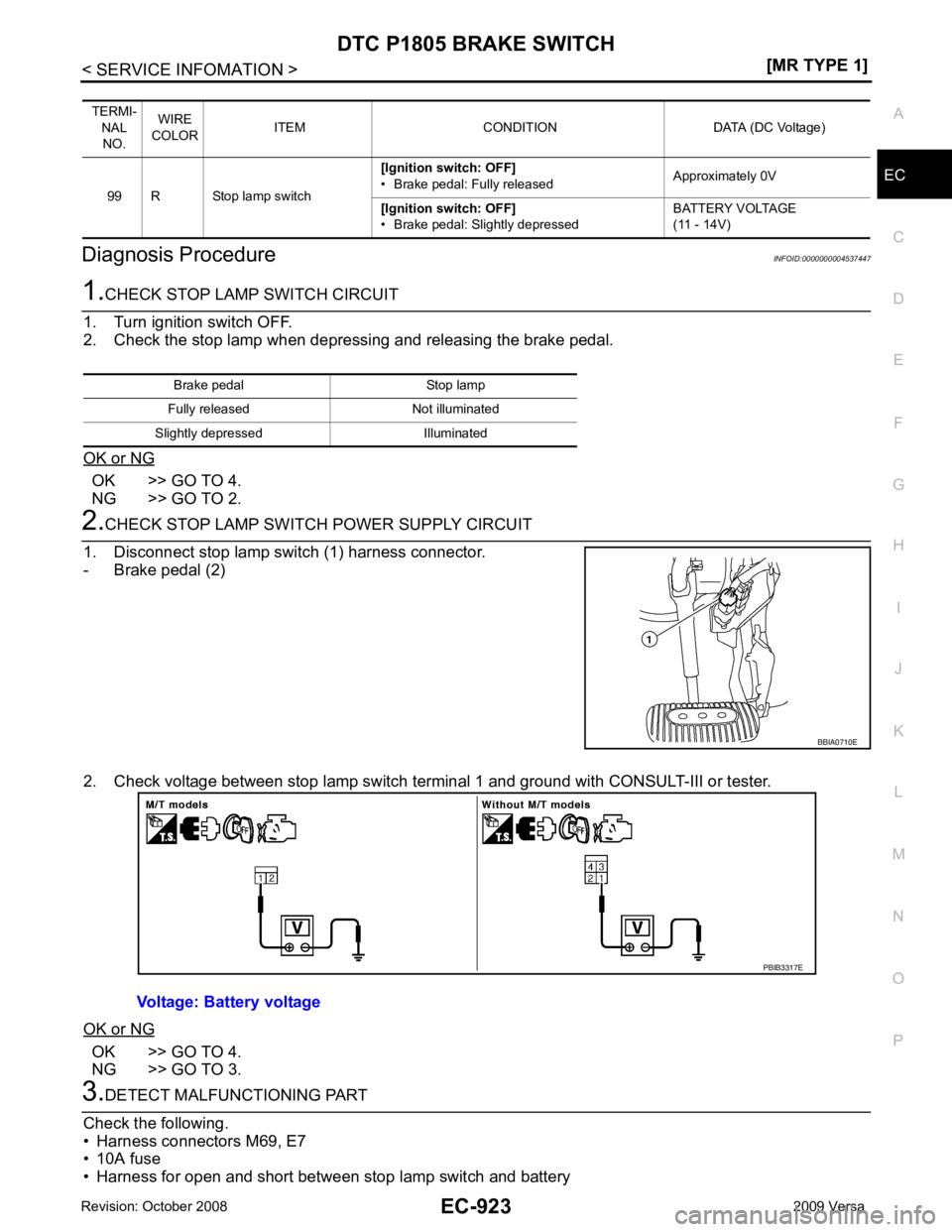
EC
NP
O
Diagnosis Procedure
INFOID:0000000004537447OK >> GO TO 4.
NG >> GO TO 2. OK >> GO TO 4.
NG >> GO TO 3. Brake pedal Stop lamp
Fully released Not illuminated
Slightly depressed Illuminated
Page 2280 of 4331
![NISSAN LATIO 2009 Service Repair Manual EC-924< SERVICE INFOMATION >
[MR TYPE 1]
DTC P1805 BRAKE SWITCH
>> Repair open circuit or short to ground or short to power in harness or connectors. 4.
CHECK STOP LAMP SWITCH INPUT SIGNAL CIRCUIT FOR NISSAN LATIO 2009 Service Repair Manual EC-924< SERVICE INFOMATION >
[MR TYPE 1]
DTC P1805 BRAKE SWITCH
>> Repair open circuit or short to ground or short to power in harness or connectors. 4.
CHECK STOP LAMP SWITCH INPUT SIGNAL CIRCUIT FOR](/img/5/57359/w960_57359-2279.png)
EC-924< SERVICE INFOMATION >
[MR TYPE 1]
DTC P1805 BRAKE SWITCH
>> Repair open circuit or short to ground or short to power in harness or connectors. 4.
CHECK STOP LAMP SWITCH INPUT SIGNAL CIRCUIT FOR OPEN AND SHORT
1. Disconnect stop lamp switch (1) harness connector.
2. Disconnect ECM harness connector.
3. Check harness continuity between stop lamp switch terminal 2 and ECM terminal 99.
Refer to Wiring Diagram.
4. Also check harness for short to ground and short to power.
OK or NG OK >> GO TO 5.
NG >> Repair open circuit or short to ground or short to power in harness connectors. 5.
CHECK STOP LAMP SWITCH
Refer to EC-924, " Component Inspection " .
OK or NG OK >> GO TO 6.
NG >> Replace stop lamp switch. 6.
CHECK INTERMITTENT INCIDENT
Refer to EC-626 .
>> INSPECTION END
Component Inspection INFOID:0000000004537448
STOP LAMP SWITCH
1. Turn ignition switch OFF.
2. Disconnect stop lamp switch harness connector.
3. Check continuity between stop lamp switch terminals 1 and 2 under the following conditions.
If NG, adjust stop lamp switch installation, refer to BR-6 , and perform step 3 again.
Continuity should exist.
Condition Continuity
Brake pedal: Fully released. Should not exist.
Brake pedal: Slightly depressed. Should exist. PBIB3318E